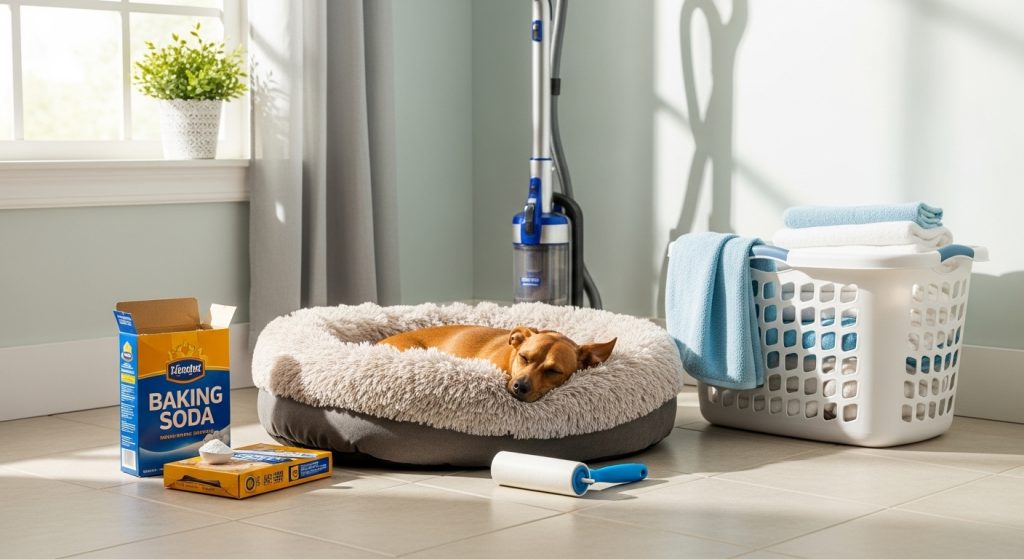A dog’s bed is more than just a soft spot to nap — it’s their comfort zone, their safe haven. But over time, that cozy nest can turn into a breeding ground for dirt, odors, fleas, and bacteria. Regular maintenance is essential for your pet’s health and for keeping your home smelling fresh.
Dog beds collect fur, saliva, dander, and even microscopic pests like mites. Neglecting to wash it can trigger allergies (for both you and your dog) and cause skin irritation. Luckily, learning how to wash a dog bed properly isn’t complicated. You just need the right tools, timing, and a few smart tricks to make it last longer.
In this guide, we’ll explore:
-
How often you should clean your dog’s bed
-
The proper washing methods for different materials
-
Tips for ongoing maintenance between washes
Let’s dive in — your furry friend deserves a spotless, comfy bed every day!
Preparation: Setting the Stage for a Proper Wash
Cleaning starts before the water even touches the bed. Preparation makes the washing process faster, more effective, and safer for your dog’s sensitive skin.
Step 1: Check the Care Label
Before you do anything, read the manufacturer’s care instructions. Some beds are fully machine-washable, while others require handwashing or spot cleaning only. Knowing the fabric type and filling material will guide your cleaning method — memory foam, polyester, or cotton fillings all need different handling.
Step 2: Remove Loose Hair and Dirt
Use a vacuum cleaner or lint roller to get rid of surface debris. A rubber glove or pet hair brush works wonders to collect stubborn fur before it enters the washing machine. This step prevents clogging and ensures a more thorough wash.
Step 3: Separate Covers (If Possible)
Many modern dog beds come with removable covers — unzip and wash them separately from the inner padding. If not removable, don’t worry; spot-cleaning the cushion and airing it out afterward works just as well.
Step 4: Choose the Right Detergent
Always use a pet-safe detergent that’s free from fragrances and harsh chemicals. Human detergents can irritate a dog’s skin or leave harmful residues. For natural alternatives, mix baking soda and white vinegar for a gentle deodorizing effect.
Washing Methods for Every Type of Dog Bed
Once your preparation is complete, it’s time to get that bed sparkling clean! How you wash it depends on the type and material of the bed. Here’s how to handle each one safely.
A. Machine-Washable Beds
For beds labeled as machine-safe:
-
Load Carefully: Avoid overstuffing the washing machine. Wash the cover and inner padding separately.
-
Use Gentle Cycles: Select cold or warm water (never hot) and a delicate wash cycle.
-
Detergent Dosage: Add a small amount of hypoallergenic detergent — less is more.
-
Extra Rinse: Run an extra rinse cycle to ensure no soap residue remains.
Pro Tip: Adding half a cup of white vinegar helps neutralize lingering odors naturally.
B. Handwashing Non-Removable Beds
If your dog’s bed can’t go into the machine:
-
Fill a bathtub or large basin with warm water and mild detergent.
-
Submerge the bed and agitate gently using your hands or a soft brush.
-
Focus on high-traffic areas — the spots where your dog’s head or paws usually rest.
-
Drain and rinse several times until water runs clear.
After washing, press out excess water but avoid wringing — twisting can damage the filling.
C. Drying the Bed
Proper drying prevents mold and mildew:
-
Air Dry: The safest option. Place the bed in a well-ventilated area or outdoors in the shade.
-
Machine Dry: Only if the label allows it. Use low heat or tumble dry with dryer balls to fluff up the filling.
Avoid direct sunlight for too long — UV rays can weaken the fabric and fade colors.
Long-Term Maintenance: Keeping the Bed Fresh Between Washes
You’ve cleaned the bed — great! Now let’s make sure it stays fresh and hygienic for as long as possible. Regular upkeep between washes saves time and reduces odors.
1. Weekly Quick Cleanups
Every week, shake out loose fur and dirt, and give the bed a quick vacuum pass. You can also sprinkle baking soda, wait 15 minutes, and vacuum again for odor control.
2. Frequent Airing Out
Once every few days, air the bed outdoors for a few hours. Sunlight kills bacteria and freshens fabrics naturally.
3. Rotate and Replace Bedding
Have two beds or spare covers so you can rotate them during cleaning. Dogs, especially heavy shedders or those with allergies, benefit from regularly replaced covers.
4. Use Washable Liners
Protect the foam interior with a waterproof inner liner. It prevents moisture from penetrating and keeps the core odor-free.
5. Groom Your Dog Regularly
A clean bed starts with a clean dog! Frequent brushing and bathing minimize shedding and dirt buildup. Grooming your pup before bedtime also reduces allergens in their sleeping spot.
6. Natural Freshening Sprays
Mix water with a few drops of lavender or chamomile essential oil (pet-safe varieties only) and lightly mist the bed for a pleasant, calming scent.
A Clean Bed Equals a Happy Pup
Keeping your dog’s bed clean is one of the simplest ways to improve their health and comfort. By following these dog bed maintenance tips, you’ll eliminate odors, prevent bacteria buildup, and extend the life of the bed.
Regular washing doesn’t just benefit your dog — it keeps your home fresher and more hygienic for everyone. Remember: a clean bed means a cleaner, happier, and healthier pet. So grab that detergent, roll up your sleeves, and give your furry friend the spotless nap spot they deserve!




